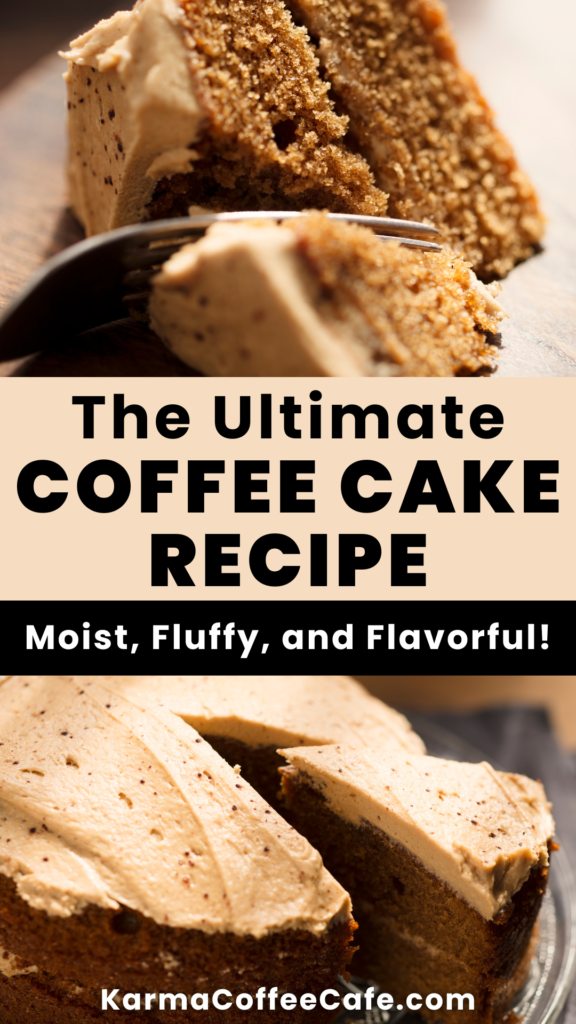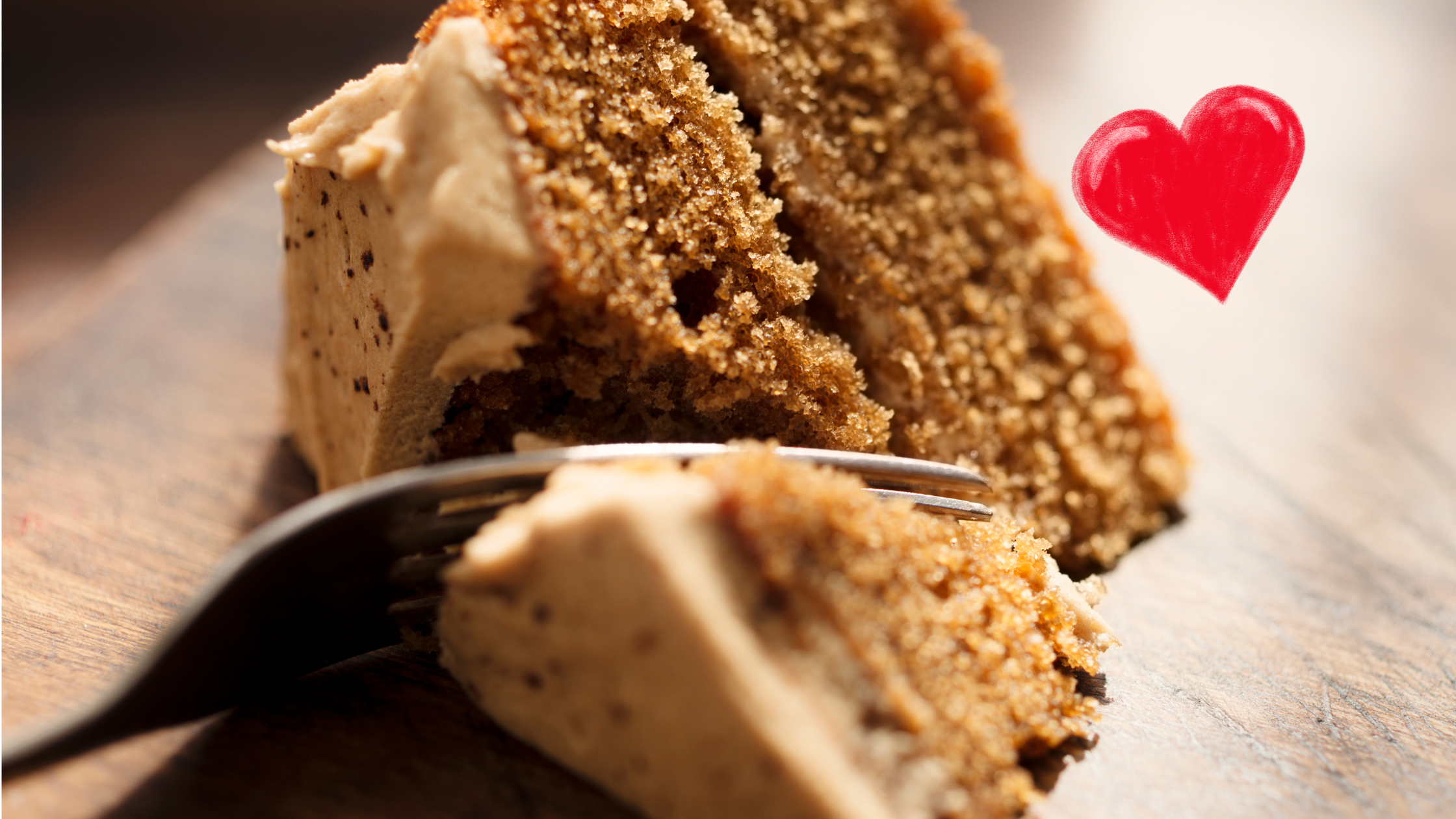This coffee cake is the perfect treat to start your day or enjoy as an afternoon snack.
It’s moist, fluffy, and packed with a rich coffee flavor that will satisfy your cravings.
The soft cake layers are balanced with a crunchy streusel topping, making every bite irresistible.
Whether you’re a seasoned baker or a beginner, this recipe is easy to follow and yields impressive results.
Coffee cake has a long history, traditionally served alongside a cup of coffee, and this recipe honors that tradition with a modern twist.

How To A Delicious Coffee Cake: At A Glance
- Step 1: Preparing the Ingredients
- Step 2: How to Make the Coffee Cake Batter
- Step 3: Preparing the Streusel Topping (or Alternative Toppings)
- Step 4: Assembling and Baking the Coffee Cake
- Step 5: Check for Doneness and Enjoy!
Ingredients
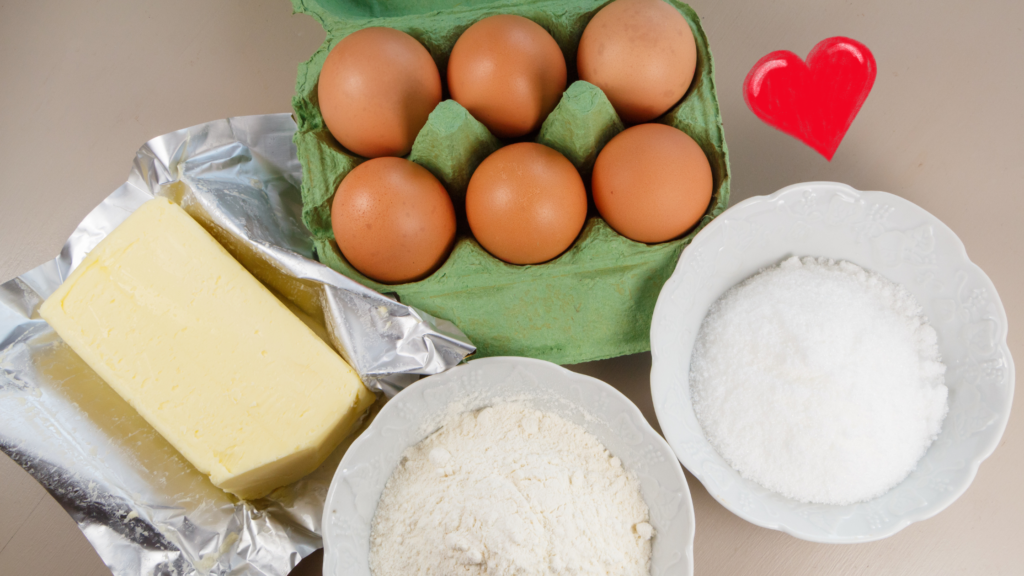
Full Ingredient List
- 2½ cups (320 g) all-purpose flour (or cake flour)
- ⅓ cup (40 g) cornflour (cornstarch)
- ½ tsp baking soda
- 1 tsp baking powder
- ½ tsp salt (omit if using salted butter)
- 4 tbsp (15 g) instant coffee powder
- ½ cup (113 g) unsalted butter (room temperature)
- ½ cup (105 g) vegetable oil (e.g., canola)
- 1½ cups (300 g) soft brown sugar (firmly packed)
- 3 large eggs (room temperature)
- 1¼ tbsp vanilla extract
- 1 tsp white vinegar
- 1½ cups (337 g) buttermilk (room temperature)
For the Whipped White Chocolate & Coffee Ganache Frosting
- 1 cup (180 g) white chocolate (couverture preferred)
- 3 cups (675 g) cream (minimum 34% fat content)
- 1½ tbsp instant coffee powder
For the Lightly Candied Walnuts
- 2 tbsp (30 g) soft brown sugar
- 1 tbsp (14 g) unsalted butter
- ½ tsp ground cinnamon
- 1 cup (100 g) walnuts (roughly chopped or halved)
Ingredient Substitutions and Variations
- Gluten-Free Option: Substitute all-purpose flour with a gluten-free flour blend.
- Dairy-Free Option: Use dairy-free butter and coconut cream in place of regular butter and cream.
- Vegan Option: Replace eggs with a flaxseed egg (1 tbsp ground flaxseed mixed with 3 tbsp water for each egg).
Spotlight on Key Ingredients
- Buttermilk: Buttermilk adds a slight tanginess and helps make the cake incredibly moist and tender. If you don’t have buttermilk, you can make a quick substitute by mixing 1½ tablespoons of vinegar or lemon juice with 1½ cups of milk and letting it sit for 10 minutes.
- Instant Coffee Powder: Using finely powdered instant coffee ensures a strong coffee flavor without adding excess liquid to the batter. This is crucial for maintaining the right texture in the cake.
- White Chocolate: Couverture white chocolate is preferred for the ganache as it has a higher cocoa butter content, resulting in a smoother, creamier frosting. However, regular white chocolate works well too.
Step-by-Step Instructions
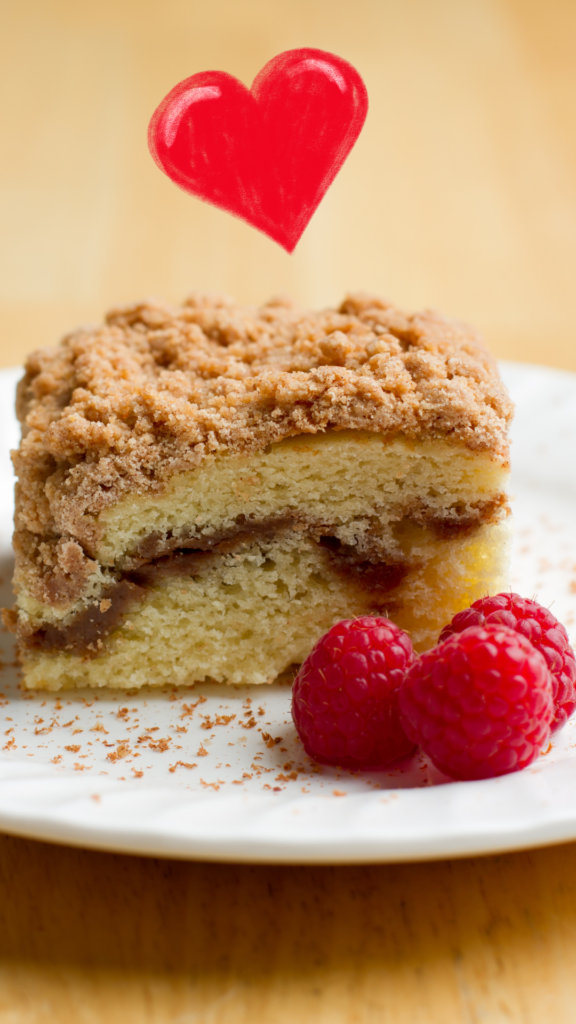
Step 1: Preparing the Ingredients
Start by gathering all your ingredients.
Ensure that your butter, eggs, and buttermilk are at room temperature.
This is important because room temperature ingredients mix more evenly, resulting in a smoother batter and a more consistent texture in the final cake.
If you forget to take them out ahead of time, you can soften butter quickly by cutting it into small pieces or warming it in the microwave for a few seconds.
To bring eggs to room temperature, place them in a bowl of warm water for a few minutes.
Step 2: How to Make the Coffee Cake Batter
Begin by preheating your oven to 160°C (320°F) with the fan on.
Grease and line two 8-inch cake tins to prevent the cake from sticking.
In a large bowl, sift together the flour, cornflour, baking soda, baking powder, salt, and instant coffee powder.
Mix well to ensure the ingredients are evenly distributed.
In a separate bowl, cream the room temperature butter, vegetable oil, and soft brown sugar using an electric mixer for about 2 minutes until the mixture is light and creamy.
This step is crucial for incorporating air into the batter, which helps the cake rise and gives it a fluffy texture.
Add the eggs one at a time, mixing well after each addition to fully incorporate them into the batter.
Next, add the vanilla extract, white vinegar, and half a cup of the buttermilk.
Mix until the wet ingredients are well combined.
Gradually add the dry ingredient mixture and the remaining buttermilk to the wet ingredients, folding gently until just combined.
Be careful not to overmix, as this can lead to a dense cake. The batter should be smooth and slightly thick.
Step 3: Preparing the Streusel Topping (or Alternative Toppings)
If you’re adding a streusel topping, prepare it by mixing together flour, brown sugar, and cinnamon in a small bowl.
Cut in cold butter until the mixture resembles coarse crumbs.
This topping adds a delightful crunch and a hint of sweetness to each bite.
If you prefer, you can substitute the streusel with lightly candied walnuts, prepared by coating walnuts in a mixture of sugar, butter, and cinnamon, then allowing them to cool and harden.
Step 4: Assembling and Baking the Coffee Cake
Divide the batter evenly between the two prepared cake tins.
Smooth the tops with a spatula to ensure an even bake.
If you’re using a streusel topping, sprinkle it evenly over the batter in each tin.
Place the tins in the preheated oven and bake for 30 minutes.
To check if the cakes are done, insert a toothpick into the center of each cake.
If it comes out clean or with just a few moist crumbs, the cakes are ready.
Step 5: How to Check for Doneness
A properly baked coffee cake should have a golden-brown top and a light, fluffy texture.
The toothpick test is the most reliable way to check for doneness.
Insert it into the center of the cake, and if it comes out clean or with a few crumbs, the cake is done.
Alternatively, you can gently press the top of the cake.
It should spring back slightly, indicating that it’s fully baked.
Once baked, allow the cakes to cool in their tins for 20 minutes before turning them out onto a wire rack to cool completely.
Baking Tips & Tricks
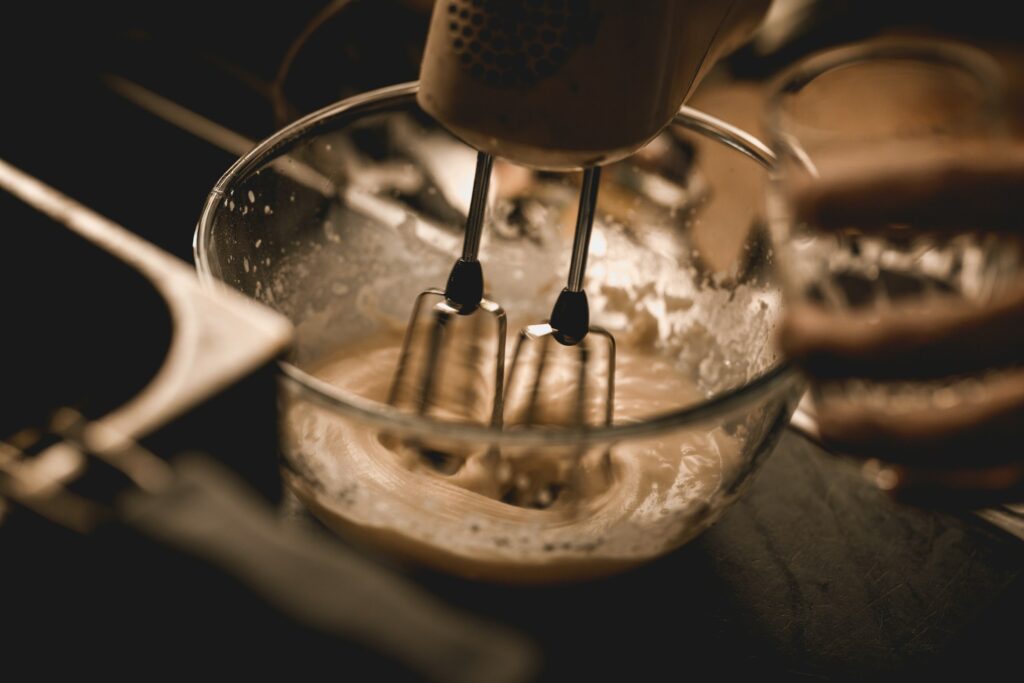
Common Mistakes to Avoid
When baking a coffee cake, there are a few common mistakes to watch out for.
One of the biggest is overmixing the batter.
Once you add the dry ingredients to the wet mixture, fold them together gently.
Overmixing can cause the gluten in the flour to develop too much, leading to a dense and tough cake.
Mix just until the ingredients are combined and the batter is smooth.
Another common mistake is overbaking.
Baking the cake for too long can result in a dry texture and a bitter taste.
Always set a timer and check the cake a few minutes before the recommended baking time is up.
How to Achieve the Perfect Crumb Texture
The crumb texture of your coffee cake is crucial.
To achieve a light and fluffy crumb, it’s important to start with room-temperature ingredients.
Cold butter, eggs, or buttermilk can cause the batter to clump, leading to an uneven texture.
Also, creaming the butter, oil, and sugar properly is key.
This step incorporates air into the batter, which helps the cake rise and creates a tender crumb.
Using the right amount of leavening agents, like baking soda and baking powder, is also vital.
Too much can cause the cake to rise too quickly and then collapse, while too little will make it dense and heavy.
Adjusting the Recipe for Different Cake Sizes
If you want to make a larger or smaller coffee cake, you can easily adjust the recipe.
For a larger cake, such as a 9×13-inch pan, you can double the ingredients.
Just be sure to extend the baking time slightly and check for doneness using the toothpick test.
For smaller cakes or cupcakes, reduce the ingredients by half.
The baking time will also be shorter, so start checking for doneness around the 20-minute mark.
If you’re using different cake tin sizes, try to keep the batter thickness similar to the original recipe to ensure even baking.
Recipe Variations
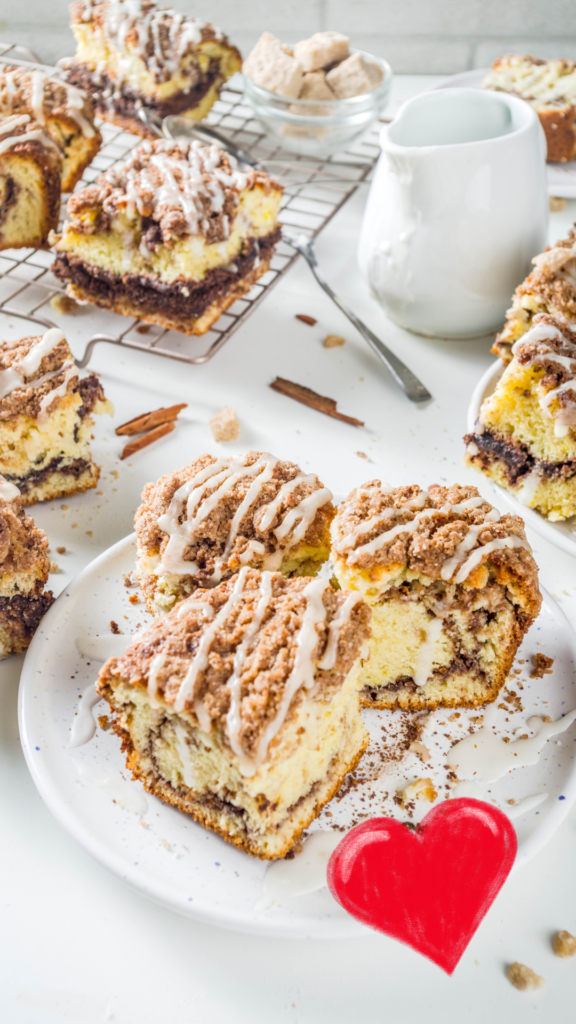
Cinnamon Streusel Coffee Cake
A classic variation that adds an extra layer of flavor and texture is the Cinnamon Streusel Coffee Cake.
To make this version, prepare a cinnamon streusel topping by mixing together flour, brown sugar, and ground cinnamon.
Cut in cold butter until the mixture resembles coarse crumbs.
Before baking, sprinkle the streusel evenly over the batter in the cake tins.
The result is a delightful contrast between the soft, moist cake and the crunchy, cinnamon-scented topping.
This variation adds a warm, spiced flavor that pairs perfectly with the rich coffee notes in the cake.
Chocolate Chip Coffee Cake
For those who love a touch of chocolate, the Chocolate Chip Coffee Cake is a must-try.
To make this variation, simply fold a cup of chocolate chips into the batter before pouring it into the cake tins.
The chocolate chips will melt slightly as the cake bakes, creating pockets of gooey chocolate that complement the coffee flavor beautifully.
You can use dark, milk, or even white chocolate chips depending on your preference.
This version is a crowd-pleaser, perfect for those who enjoy the combination of coffee and chocolate.
Seasonal Variations (Pumpkin Spice, Apple Cinnamon)
Seasonal flavors can take your coffee cake to the next level.
For a Pumpkin Spice Coffee Cake, add 1 cup of pumpkin puree and 2 teaspoons of pumpkin pie spice to the batter.
The pumpkin not only adds moisture but also a warm, autumnal flavor that’s perfect for fall gatherings.
If you prefer a fruity twist, try the Apple Cinnamon Coffee Cake.
Dice one or two apples and fold them into the batter along with 2 teaspoons of ground cinnamon.
The apples will soften during baking, adding a sweet, juicy contrast to the rich cake.
This variation is ideal for late summer and fall, when apples are in season.
Adding a Glaze or Icing
A simple glaze or icing can elevate the presentation and flavor of your coffee cake.
To make a basic glaze, whisk together powdered sugar with a few tablespoons of milk or cream until smooth.
For added flavor, you can mix in a teaspoon of vanilla extract, or for a citrusy twist, add a little lemon juice.
Drizzle the glaze over the cooled cake for a sweet finishing touch.
Alternatively, you can make a cream cheese icing by beating softened cream cheese with powdered sugar and a splash of vanilla extract.
This rich and tangy icing pairs wonderfully with both the plain coffee cake and the cinnamon streusel version.
Storage and Freezing Instructions
To keep your coffee cake fresh and delicious, proper storage is key.
At room temperature, the coffee cake should be stored in an airtight container, which will help maintain its moisture and prevent it from drying out.
It can be kept this way for up to 2 days.
If you need to store it for longer, refrigerate the cake in an airtight container, where it will stay fresh for up to 5 days.
When refrigerating, bring the cake to room temperature before serving to enjoy its full flavor and texture.
If you want to freeze the coffee cake for later use, first wrap it tightly in plastic wrap to prevent freezer burn, then place it in a freezer-safe bag or container.
The cake can be frozen for up to 3 months.
When you’re ready to enjoy it, thaw the cake in the refrigerator overnight.
To reheat, you can either warm individual slices in the microwave for 10-15 seconds or place the whole cake in a preheated oven at 350°F (175°C) for about 10 minutes until it’s warmed through.
This will refresh the cake’s texture and bring back that freshly baked taste.
Healthier Alternatives

Lower-Calorie Version
For a lower-calorie coffee cake, you can make a few simple substitutions without sacrificing flavor.
One effective swap is using unsweetened applesauce in place of some or all of the butter or oil in the recipe.
This reduces the fat content while adding moisture to the cake.
Additionally, you can reduce the sugar by about a third, which will lower the overall calorie count.
The natural sweetness from the applesauce can help make up for the reduced sugar, keeping the cake just as satisfying.
Gluten-Free/Dairy-Free Adaptations
To make the coffee cake gluten-free, simply replace the all-purpose flour with a gluten-free flour blend that includes xanthan gum for better structure.
Ensure that all other ingredients, such as baking powder and instant coffee, are also gluten-free.
For a dairy-free version, substitute the butter with a plant-based margarine or coconut oil, and use a dairy-free milk like almond or oat milk in place of buttermilk.
Coconut cream or a similar dairy-free alternative can be used for the ganache frosting, ensuring the cake remains rich and creamy.
Sugar-Free Option
If you need to cut out sugar, consider using a natural sweetener like stevia or monk fruit sweetener.
These sugar substitutes can be used in place of granulated sugar, but be sure to check the conversion ratios, as they are often much sweeter than sugar.
Using a sugar-free white chocolate in the ganache frosting can also help maintain the cake’s sweetness without added sugars.
Conclusion
This coffee cake recipe is a perfect blend of rich flavors and tender texture, making it a delightful treat for any occasion.
Whether you stick to the classic version or try one of the variations, you’re sure to impress your family and friends.
Give this recipe a try and enjoy the warmth and comfort of a homemade coffee cake.
If you enjoyed this recipe, please share it with others, leave a comment, or let us know how it turned out for you.
Happy baking!
Frequently Asked Questions (FAQs)
Can I Use Freshly Brewed Coffee Instead of Instant Coffee?
Using freshly brewed coffee in place of instant coffee is not recommended for this recipe.
Instant coffee powder is used because it provides a strong coffee flavor without adding extra liquid to the batter.
Freshly brewed coffee would introduce too much liquid, which could alter the texture of the cake and make it too dense.
Stick with instant coffee powder for the best results.
How Long Does Coffee Cake Last?
When stored properly, coffee cake can last for several days.
At room temperature, it will stay fresh in an airtight container for up to 2 days.
If you refrigerate it, the coffee cake can last up to 5 days.
For longer storage, you can freeze the cake for up to 3 months.
Just be sure to wrap it tightly in plastic wrap and place it in a freezer-safe container.
What to Do If My Cake is Too Dry?
If your coffee cake turns out too dry, there are a few things you can do to salvage it.
One quick fix is to brush the cake with a simple syrup made of equal parts sugar and water.
This will add moisture back into the cake.
Another option is to serve the cake with a dollop of whipped cream or a drizzle of icing, which can help mask any dryness.
To avoid dryness in the future, be careful not to overbake the cake, and make sure your ingredients are fresh and properly measured.
